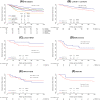Pattern of recurrence of early breast cancer is different according to intrinsic subtype and proliferation index
- PMID: 24148581
- PMCID: PMC3978680
- DOI: 10.1186/bcr3559
Pattern of recurrence of early breast cancer is different according to intrinsic subtype and proliferation index
Abstract
Introduction: Recurrence risk in breast cancer varies throughout the follow-up time. We examined if these changes are related to the level of expression of the proliferation pathway and intrinsic subtypes.
Methods: Expression of estrogen and progesterone receptor, Ki-67, human epidermal growth factor receptor 2 (HER2), epidermal growth factor receptor (EGFR) and cytokeratin 5/6 (CK 5/6) was performed on tissue-microarrays constructed from a large and uniformly managed series of early breast cancer patients (N = 1,249). Subtype definitions by four biomarkers were as follows: luminal A (ER + and/or PR+, HER2−, Ki-67 <14), luminal B (ER + and/or PR+, HER2−, Ki-67 ≥14), HER2-enriched (any ER, any PR, HER2+, any Ki-67), triple-negative (ER−, PR−, HER2−, any Ki-67). Subtype definitions by six biomarkers were as follows: luminal A (ER + and/or PR+, HER2−, Ki-67 <14, any CK 5/6, any EGFR), luminal B (ER + and/or PR+, HER2−, Ki-67 ≥14, any CK 5/6, any EGFR), HER2-enriched (ER−, PR−, HER2+, any Ki-67, any CK 5/6, any EGFR), Luminal-HER2 (ER + and/or PR+, HER2+, any Ki-67, any CK 5/6, any EGFR), Basal-like (ER−, PR−, HER2−, any Ki-67, CK5/6+ and/or EGFR+), triple-negative nonbasal (ER−, PR−, HER2−, any Ki-67, CK 5/6−, EGFR−). Each four- or six-marker defined intrinsic subtype was divided in two groups, with Ki-67 <14% or with Ki-67 ≥14%. Recurrence hazard rate function was determined for each intrinsic subtype as a whole and according to Ki-67 value.
Results: Luminal A displayed a slow risk increase, reaching its maximum after three years and then remained steady. Luminal B presented most of its relapses during the first five years. HER2-enriched tumors show a peak of recurrence nearly twenty months post-surgery, with a greater risk in Ki-67 ≥14%. However a second peak occurred at 72 months but the risk magnitude was greater in Ki-67 <14%. Triple negative tumors with low proliferation rate display a smooth risk curve, but with Ki-67 ≥14% show sharp peak at nearly 18 months.
Conclusions: Each intrinsic subtype has a particular pattern of relapses over time which change depending on the level of activation of the proliferation pathway assessed by Ki-67. These findings could have clinical implications both on adjuvant treatment trial design and on the recommendations concerning the surveillance of patients.
Figures





References
-
- Perou CM, Sørlie T, Eisen MB, van de Rijn M, Jeffrey SS, Rees CA, Pollack JR, Ross DT, Johnsen H, Akslen LA, Fluge O, Pergamenschikov A, Williams C, Zhu SX, Lønning PE, Børresen-Dale AL, Brown PO, Botstein D. Molecular portraits of human breast tumours. Nature. 2000;15:747–752. - PubMed
-
- Sorlie T, Tibshirani R, Parker J, Hastie T, Marron JS, Nobel A, Deng S, Johnsen H, Pesich R, Geisler S, Demeter J, Perou CM, Lønning PE, Brown PO, Børresen-Dale AL, Botstein D. Repeated observation of breast tumor subtypes in independent gene expression data sets. Proc Natl Acad Sci USA. 2003;15:8418–8423. - PMC - PubMed
-
- Wirapati P, Sotiriou C, Kunkel S, Farmer P, Pradervand S, Haibe-Kains B, Desmedt C, Ignatiadis M, Sengstag T, Schütz F, Goldstein DR, Piccart M, Delorenzi M. Meta-analysis of gene expression profiles in breast cancer: toward a unified understanding of breast cancer subtyping and prognosis signatures. Breast Cancer Res. 2008;15:R65. - PMC - PubMed
Publication types
MeSH terms
Substances
LinkOut - more resources
Full Text Sources
Other Literature Sources
Medical
Research Materials
Miscellaneous

